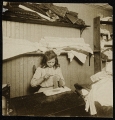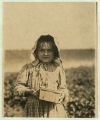Lewis W. Hine: The reform of child labour in America
    
Contents Fragments Photographer Theme PhV Checklist
As the number of children employed in industrial occupations in the United States was increasing in the late nineteenth and early twentieth centuries so there was a reaction against it based on health, educational, social and religious rationales. Edgar Gardner Murphy (1869-1913), who had served as priest of the Episcopal Church for twelve years, saw the dangers of unfettered child labor and proposed a National Child Labor Committee[1] bringing together different groups with similar motivations.
On 25th April 1904 a meeting was held at Carnegie Hall in New York City to address the plight of working children. It was at that meeting that the National Child Labor Committee (NCLC) was established. By 1907 the organisation had gained considerable support and it was charted by an Act of Congress.
To raise public awareness in early 1908 they hired Lewis Hine to photograph working children and it was appreciated that his images and supporting notes would serve as documentary evidence of the appalling working conditions of young workers. By 1912 a Children‘ Bureau was established in both the U.S. Department of Commerce and the U.S. Department of Labor which indicated progress but laws were introduced at the state or city level resulting in a patchwork of differing standards and enforcement. It was not until Fair Labor Standards Act of 1938 that child labor was effectively banned or regulated nationwide.
Lewis Hine[2] traveled through the United States as an investigator and a photographer for the National Child Labor Committee (NCLC) and his photographs were an impetus in promoting legislation to restrict child labor. To gain access to factories Lewis Hine pretended to be a fire inspector or a salesman as owners had no desire to have proof of their actions, which although legal were morally unjustifiable. The Keating-Owen Child Labor Act[3] of 1916 was the first attempt but subsequent rulings, supported by powerful industrial lobbies, prevented its effectiveness and it was not until the Fair Labor Standards Act was passed by Congress on 25th June 1938 that minimum ages for the employment of children could be enforced. It was through the photographic evidence of Lewis Hine that society was forced to recognize the injustices and eventually to address them with appropriate laws.
    
PhVLewis W. Hine: Workers in cotton mills
     
PhVLewis W. Hine: News boys and girls
   
PhVLewis W. Hine: Agricultural labour
The importance of these photographs is highlighted in a letter that Owen Lovejoy (former director of the NCLC - National Child Labor Committee and Associate Director of the American Youth Commission) wrote to Lewis Hine on 21 July 1938:
Beginning in 1905 with your first service to the National Child Labor Committee when you traveled this country from end to end discovering and exhibiting examples of types of children and youth in various forms of labor on through to the more humane days when the littlest ones were emancipated and you and I both felt we might turn our attention in another direction, you would have a pictorial document of rare interest and one which no one can duplicate. In my judgment the work you did under my direction for the National Child Labor Committee was more responsible than any or all other efforts to bring the facts and conditions of child employment to public attention. The evils inherent in the system were intellectually but not emotionally recognized until your skill, earnestness, devotion, vision and artistic finesse focused the camera intelligently, sympathetically and effectively on social problems involved in American industry.
Cordially yours, Owen R. Lovejoy[4]
In 1954, to commemorate its fiftieth anniversary, the National Child Labor Committee presented to the Library of Congress official records, correspondence, speeches, reports, press releases, and clippings from the period 1904 to 1953. This resource is regarded as one of the most significant documentary projects in the history of photography.
Footnotes
- Λ NCLC
The website includes a brief history.
- Λ There are multiple studies on Lewis Hine including - Judith Mara Gutman, 1967, Lewis W. Hine and the American Social Conscience, (New York: Walker); Walter Rosenblum et al., 1977, America and Lewis Hine: Photographs, 1904–1940, (New York: Aperture); Daile Kaplan (ed.), 1992, Photo Story: Selected Letters and Photographs of Lewis Hine, (Washington, D.C.: Smithsonian Institution Press); Alison Nordström & Elizabeth McCausland, 2012, Lewis Hine, (D.A.P./Distributed Art Publishers, Inc.)
- Λ Keating-Owen Child Labor Act of 1916
The website includes background and document transcripts.
- Λ Owen Lovejoy letter to Lewis Hine (21 July 1938:) quoted in: Daile Kaplan (ed.), 1992, Photo Story: Selected Letters and Photographs of Lewis Hine, (Washington, D.C.: Smithsonian Institution Press), p. 110
Explore... | | Photographer | Theme | Images | www.luminous-lint.com
Creative Commons, Attribution-NonCommercial 4.0 International |
|

